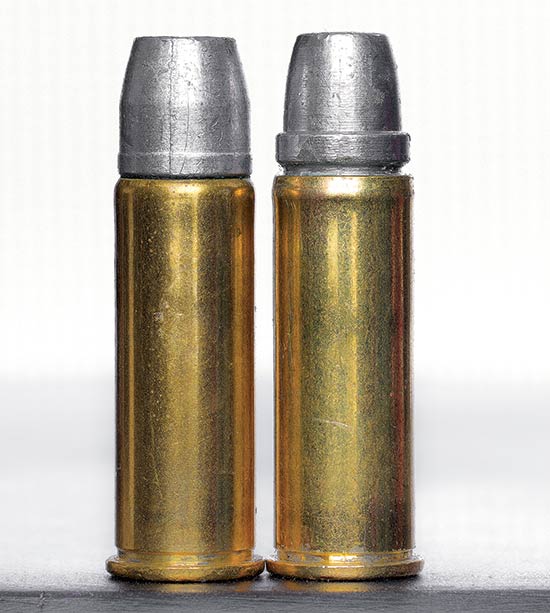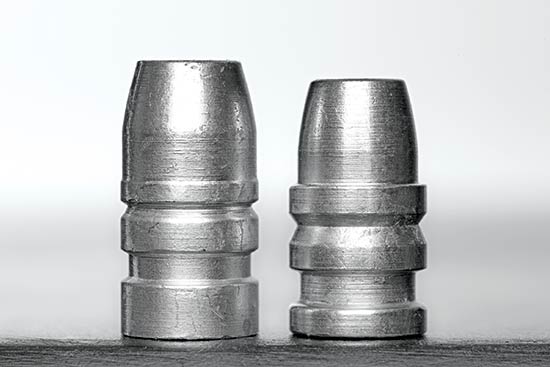Avoiding Crimp Failures
Heavy Recoiling Revolver Dangers

Note the SWC bullet protrusion after 14 recoil pulses at 1,320 fps. This could occur
if a shooter fired a few rounds, emptied the cylinder, chambered un-fired rounds later,
and did that several times. Very common on the range or in the field at times. Some loaded
ammo might easily go through five or six — or more — impulses.
As anyone who has fired heavy-for-caliber bullets at full pressure from a large caliber revolver can attest — the experience is exhilarating! The recoil pulse is basic Newton, for every action there is an equal and opposite reaction. Simply stated, the more powerful the load, the heavier the recoil.
This is more than simply an inconvenience, as it can play havoc with many handloaders and their ammunition. The harder the revolver recoils, the greater the stress on the bullet crimp as it attempts to keep the cartridge from elongating. This is simply basic to all large caliber revolvers firing full-power, heavy-bullet ammunition. This varies, even with the same load formula, depending on the weight of the revolver and the age of the brass. Combined with the great variation in crimp groove design, as well as crimp die design, it becomes clear the crimping “station” requires much consideration if really big loads are being built.
For the crimp to hold against the stresses of heavy recoil, the crimp die must have a complementary contour with that of the crimp groove, or crimp-failure is very likely. And when the crimp fails, bullet noses often extend far enough out of the case the nose of the round may not clear the forcing cone, effectively locking-up the revolver. The crimping of heavy cast bullets in the large caliber revolver requires much of the loader, if crimp failures are to be avoided.
Jacketed Vs. Cast
Crimping a jacketed bullet is quite different from crimping a lubricated cast bullet, and if you load both, the use of two different crimpers is invariably required. This is primarily due to lubricated cast bullets possessing, and needing, deeper crimp grooves than those found on jacketed bullets.
Since jacketed bullets tend to have shallow crimp grooves, the builder needs to use a crimp die with shallow crimping characteristics. Otherwise, the die will try — unsuccessfully — to push the forward edge of the case too deeply into the jacketed bullet’s shallow crimp groove. This results in a bulge just below the crimp. You’ve likely seen this in some hand-loaded rounds, and even in some factory loads. This reduces neck tension, compromising the strength of the crimp.
However, the same die used to crimp jacketed bullets will usually lack the ability to really bend the mouth of the cases into the cast bullet’s deeper crimp groove. This is a necessity when crimping lubricated cast bullets against the forces of major recoil.
There’s also the matter of the crimp groove’s contour, especially on cast bullets. You’re looking at whether the bottom half of the crimp groove is abrupt enough to allow an aggressive crimper to produce a crimp capable of hanging on to the bullet during heavy recoil. Some of the older cast bullet designs use very steep crimp grooves, and these are far less effective at holding against heavy recoil than one more abrupt and less steep.
The bottom of the crimp groove should be contoured more like a “hand hold” as opposed to a steep and consequently slippery surface allowing the bullet to wedge its way out of crimp during recoil. Steep crimp grooves such as found on many early SWC bullets are old designs popularized by those using a single assembly die to seat and crimp the bullet at the same time. This used to be a fairly standard assembly technique.

Both cartridges subjected to 10 recoil pulses, yet the Hammerhead bullet (L)
remains in place, whereas the SWC bullet has elongated significantly. This is despite
the fact both bullets were driven to 1,320 fps and the Hammerhead bullet weighs 310 gr.
while the SWC weighs only 250 gr. The heavier bullet at the same speed generates more
recoil, yet it was the lighter bullet at the same speed jumping its crimp.
Specific Issues
A concern exclusive to cast bullet users is the “bulldozing” of bullet lubricant from the area of the lube groove and bearing surface, to the area of the crimp groove during bullet seating. Invariably some lubricant gets shoved into the crimp groove during the crimping process, and if there’s not enough room for the lubricant to “get out of the way” of the bending/crimping case, there will be a loss in contact between the case and the bullet, since lubricants can’t be compressed. This will cause a sort of bulge easily overlooked, yet will compromise the crimp’s ability to hold the bullet stationary during ignition.
Another important issue impacting the crimping of cast bullets and jacketed bullets is the neck tension produced when the bullet is seated into the case. There should be a definite “feel” of a case stretching around the bullet. This will assist the crimp, and help to avoid elongation of the cartridge under recoil.
Unfortunately there’s no simple advice or practice to assist the advanced handloader in dealing with these issues. Only through trial and error can the builder find the right combination of crimp groove design and crimp die design to hold the bullet stationary against the formidable recoil of heavy-for-caliber bullets at full speed.
When in the market for a good casting block, look for one with a relatively abrupt lower surface on the crimp groove. That will improve the performance of all crimper dies used with it. But more often than not, we choose a given bullet for characteristics other than crimp groove design. But crimp failure can be a serious problem, so always take a good look at a new bullet’s crimp groove before deciding it’s just right for the biggest loads.





